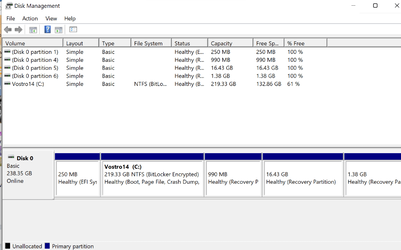- Local time
- 1:47 AM
- Posts
- 4,953
- Location
- Buffalo, Wyoming
- OS
- Win11 Pro RTM Version 24H2 Build 26100.4202
The only possibility I see large enough is the 16GB Recovery partition but nothing strange shows when totalling the partitions sizes. Maybe the formatting is taking about 10% of the total of 256GB??Just a thought! Have you checked in Disk Management to see if the laptop has another drive that doesn't have an assigned drive letter?

Update, I just used GPARTED [GNOME Partition Editor] bootable LiveUSB to verify what Win11 is showing.
Last edited:
My Computers
System One System Two
-
- OS
- Win11 Pro RTM Version 24H2 Build 26100.4202
- Computer type
- Laptop
- Manufacturer/Model
- Dell Vostro 3400
- CPU
- Intel Core i5 11th Gen. 2.40GHz
- Memory
- 12GB
- Hard Drives
- 256GB SSD NVMe M.2
-
- Operating System
- Win11 Pro RTM Version 24H2 Build 26100.4202
- Computer type
- PC/Desktop
- Manufacturer/Model
- Dell Vostro 5890
- CPU
- Intel Core i5 10th Gen. 2.90GHz
- Memory
- 16GB
- Graphics card(s)
- Onboard, no VGA, using a DisplayPort-to-VGA adapter
- Monitor(s) Displays
- 24" Dell
- Hard Drives
- 512GB SSD NVMe, 4TB Seagate HDD
- Browser
- Firefox, Edge
- Antivirus
- Windows Defender/Microsoft Security






